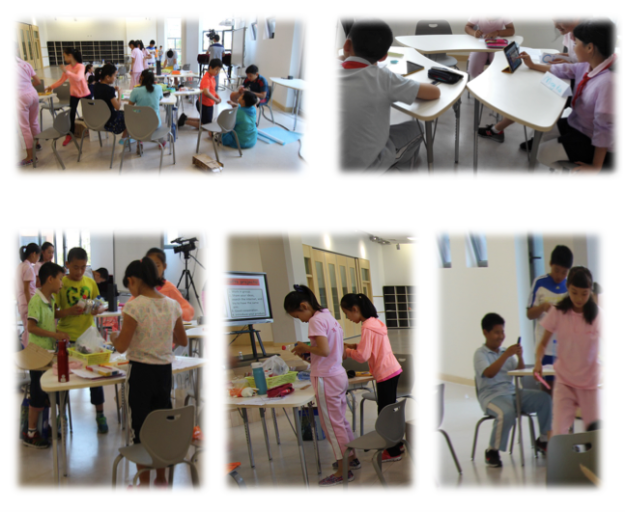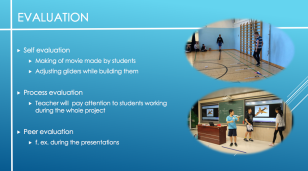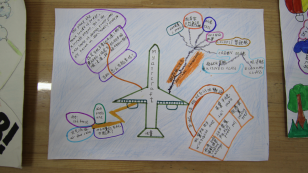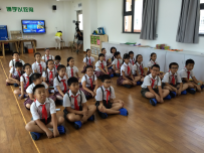
Jaana’s and Yiwen’s project was about the gliders and flying effect. The theme came out from the Finnish Curriculum and Yiwen’s will to have a project about gliders. For Jaana this theme was a great option, because Jaana’s and Petri’s students were on the 5th Grade and they studied physical information about the planes and flying effect during the spring 2016, so this project was easily integrated to their physics lessons.
From teachers’ point of view the main point of this project was collaboration between Finnish and Chinese teachers. That was the first time for both of us, so that’s why it was at first quite exciting. We tried to get to know each other via WeChat and in Beijing we started to work together and at the same time we got to know each other better. On the first day we went through our project plan and made decisions how to make gliders. Yiwen also showed Jaana, what kind of glider she had built with her students by using ready cut pieces. Jaana also showed Yiwen, how to fold a simple paper glider. As a common decision we decided to give students an opportunity to choose, how they would make the glider: by using ready cut pieces or folding the glider.
From students’ point of view the main point was to learn group working skills, learn information about the structure of the plane, to learn information about forces which affect to the plane during the flight and also to learn to make a glider by using different kind of materials and also to learn the techniques how to throw the glider.

Our project plan contained 8 lessons. Lessons from 1-5 contained introduction, studying information about the gliders and flying effect, making mind maps in groups of 3-4 and presenting mind maps. We started this part in Beijing by teaching students the specific words in English and in Chinese, because words were quite new for students. To find correct words in English students used Chinese-English dictionary on iPads. Then they came one by one to the front of the classroom to clue words into the picture of the plane. At the same time we also discussed what is the meaning of each part and students found answers from Internet or just thought what could be the answer and then told their idea to the others. The most important question was, why the planes need all those parts and how those parts affect to the plane and flying effect.
This slideshow requires JavaScript.
After the common start students made mind maps in groups. They got three questions to find out: how do you think each part of the plane affects its flying effect, which forces act on the plane during the take off, gliding and landing and why the plane can fly. To find information students used Baidu on iPads. One student also gave others a tip to find information from the site en.wikipedia.org. That was something new for others, because this time they found information mainly in English, although some of them also found information in Chinese and used Baidu translator to translate it into English or to translate information from English into Chinese. As a teacher I think it was a correct way to find and understand found information, because there were so much specific words that they didn’t know in English or in some cases not even in Chinese.
Students used 3 lessons to make their mind maps. After that they presented their mind maps to others. For them it was exciting that all students had to go to front of the class, not only one. During the presentation they also taught each others by drawing pictures and writing down the most important words f. ex. about the forces that affect to the plane. One group also showed animations from wikipedia about the aileron and elevator.

In our project plan lessons 6-7 were for making a glider. In Beijing we offered students a possibility to choose, how they would like to make their glider: by using ready cut pieces or by folding a paper glider. On our demo lesson we had a 60 minutes to implement this part, so after a short introduction about our project and information rehearse with students, students started to work in pairs.
Many of our students chose to use ready cut pieces, but there were four eager boys, who would liked to know which one flies better, the folded glider or the glider made by the ready cut pieces. At the beginning of the lesson they thought that ready cut piece glider flies better, but after testing and adjusting their folded glider flow better, even through the open window. 😉
During the testing students also marked down how far their glider flies. Then they had to think about, how to improve their glider to fly further. For this they had a work sheet to draw the altitude and to mark down, how they adjusted their glider. This work sheet worked well and gave students more understanding what they are learning.

Demo lesson was filmed from each corner of the class room. At first all students were quite excited because of the cameras, but quite quickly everyone forgot all the cameras. The audience followed our lesson in the hall next to our classroom. After our lesson we teachers went to stage to tell more about our project and about evaluation. All slides we made in both languages and all questions and answers we got and gave also in both languages. That way all members in audience understood what we want to say. Tiina and audience also asked us about our project and collaboration. Jaana answered all in English and Yiwen translated it into Chinese.
In Shenzhen we had a same kind of project, but in there their own teacher had started the project by making mind maps with her students. On the first day we had 4 lessons with the students and during those lessons students got to know information about Finland, made posters about the differences and similarities between the Finnish and Chinese schools and after that we taught them information about the gliders and flying effect. This time Yiwen taught them more in Chinese than in Beijing, because the students in Shenzhen were younger and they didn’t know so much about the theme in English. After the common start students continued working with their mind maps. Many of them made their mind maps both in Chinese and English, because writing everything in English was quite hard for them, they were so young. After finishing the mind maps they presented them to others in English. One boy was a translator for some groups, because they were so shy to have their presentation in English. This kind of collaboration worked well and every group could have their presentation.
On the demo lesson in Shenzhen we had the same PowerPoint introduction than in Beijing in both languages and after that a short rehearse about the main parts of the plane in English. After that we taught students how to fold a simple paper plane. After that we told them about the schedule and they started to fold planes by using different kind of papers. They also had a work sheet such like in Beijing. During the testing students noticed that the paper can’t be too thin or too thick, so they had to test which paper could be the best option for folding.


For me as a Finnish teacher this experience was amazing and this opened my eyes to see the meaning of the global collaboration deeper! It was nice to collaborate with the Chinese teacher Yiwen, all students, all professors from Beijing and also I learned a lot of Chinese culture and school system. I think I also learned, how to plan and have project with teacher who I haven’t known long – collaboration doesn’t depend on how well you know your partner, but it depends on how much you want to work together and find the common understanding.
My deepest will is to have more collaboration with Yiwen next year. 🙂












































































